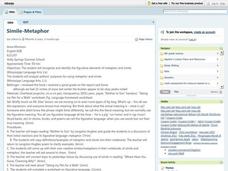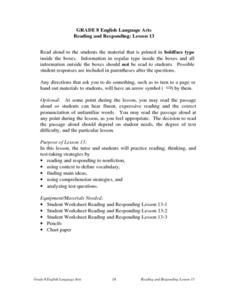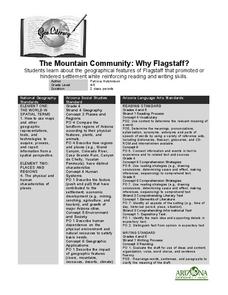Curated OER
The Pledge of Allegiance
Students explore the meaning of the Pledge of Allegiance. In this civics instructional activity, students examine the document, define related vocabulary words, and rewrite it in their words.
Curated OER
Writing About Art: Objective vs. Subjective
Students examine the sculpture "Head With Horns" by Paul Gauguin. In this perspectives lesson, students discuss what the terms "objective" and "subjective" means. Students are shown the sculpture and write their subjective and objective...
Curated OER
Famous People Research Project
Fourth graders research a famous person in Michigan history. They will use at least three different resources including technology to conduct their research. They then will use various forms of technology to create individual research...
Curated OER
There Was an Old Lady. . .
Students alter a familiar short poem or song with synonyms and antonyms. In this synonym and antonym lesson, students replace the synonyms or antonyms in the text and discuss the changes in meaning. Students share their words.
Curated OER
Homophones-Grade 3
Third graders engage in a discussion of homophones with the teacher. In this homophone lesson, 3rd graders read "The King Who Rained" and circle homophones used in sentences taken from the book. Students share their work and play a game...
Curated OER
Clap Syllable
Students identify the number of syllables in a word. They count the beats in a word and realize that one beat -words are shorter than three beat words.
Curated OER
Language, Communication, and Successful Conflict Resolution
Middle schoolers consider how communication skills may diffuse conflict. In this conflict resolution lesson, students play a word game and discuss how vocabulary may contribute to creating conflict of diffusing it.
Curated OER
Rollin’ on the River: Identifying Jargon
Students identify jargon in poetry, prose and fiction. In this literature lesson, students will read selections from Mark Twain and identify figurative langauge, focusing on jargon.
Curated OER
Equations, Formulas and Identities
Pupils rewrite word problems using the correct symbols. In this algebra lesson, students find the trigonometric identities and use them to solve problems. They write equations for the trigonometric ratios.
Curated OER
Logic- Always and Sometimes
Second graders investigate logical reasoning. In this math vocabulary lesson, 2nd graders explore the words: always and sometimes while evaluating story problems. Students create images on KidPix to illustrate their understanding of the...
Curated OER
Exploring Descriptive Language With Different Parts of Speech
Young scholars practice experiencing writing with appropriate language and incorporating the eight parts of speech. They assess that many words have multiple functions when used in different contexts. Each student free writes in response...
Curated OER
Snow Day
Third graders examine the effects of a snow day on various people in the community. They listen to the book "Snow Day" by Betsy Maestro, complete a graphic organizer of people affected by the snow day, and write a story from the point of...
Curated OER
Simile And Metaphor
Students engage in a lesson about metaphor and simile while using them in different contexts. They are asked to share some samples that are designed by them to other members of the class. Students practice writing them with the help of...
Curated OER
Maize to Maquiladoras: Movement from Mexico to Arizona
Fourth graders label maps of Arizona and Mexico to show the people, goods, and ideas that have moved between the two places. In this Arizona and Mexico lesson plan, 4th graders summarize the effects of the movement on Arizona life.
Curated OER
Dialog Expansion, Structure Drills
Students practice speaking sentence patterns used in classroom dialogs. They use new vocabulary within the sentence patterns.
Curated OER
Native American Legends
Second graders will engage in an in-depth study of Michigan Native American culture comparing and contrasting the culture of today with that of the past. They will also read a variety of Native American literature focusing on the story...
Curated OER
Reading and Responding -- Lesson 13
Fourth graders work independently or in a small group to (1) read a fictional passage, (2) use context to define unfamiliar vocabulary, (3) use comprehension strategies, and (4) make inferences. Reading passage and teacher script is...
Curated OER
Reviewing Language
Eighth graders examine some of the basics of the writing process in order to improve long-term writing goals. They apply the concepts of using speech, prefixes, and suffixes. Students use and describe the different steps of the writing...
Curated OER
Westward Ho: The Difficulties of Emigrants Moving West
Learners research the journey west of 19th century emigrants. In this pioneer lesson, students read the letters and diaries of a fictitious family traveling on the Oregon Trail. They mark their route on a US map, create a chart showing...
Curated OER
The Mountain Community: Why Flagstaff?
Students identify geographical features that hindered or promoted settlement in the city of Flagstaff, Arizona. In this settlement lesson plan, students write a summary of what they learned and identify geographical features on a map.
Curated OER
Vocabulary Tables
Learners view a sample vocabulary table based on words related classical music. After students have had a chance to view the table, they break up into groups and create their own vocabulary tables based on a certain subject.
Curated OER
Prehistoric Native American Lesson Plan: Pictionary with the Past
Students participate in a vocabulary exercise at a website dedicated to Prehistoric Native Americans.
Curated OER
What's Organic?
Young scholars define and discuss terms organic and synthetic, read article pertaining to organic agricultural practices in Oklahoma, complete worksheet, grow plants using both commercial and organic fertilizer, compare growth rates, and...
Curated OER
Introduction to Arithmetic and Geometric Sequences
Students examine the concept of sequences. Students create a sequence using varied starting numbers, multipliers, and add on values. Students practice determining the starting values to use in order to produce a desired sequence.

























